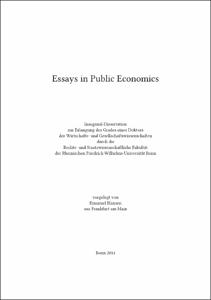Essays in Public Economics

Essays in Public Economics

| dc.contributor.advisor | Hellwig, Martin F. | |
| dc.contributor.author | Hansen, Emanuel | |
| dc.date.accessioned | 2020-04-19T15:15:25Z | |
| dc.date.available | 2020-04-19T15:15:25Z | |
| dc.date.issued | 26.11.2014 | |
| dc.identifier.uri | https://hdl.handle.net/20.500.11811/5964 | |
| dc.description.abstract | This thesis consists of three self-contained chapters. The first chapter studies political competition with endogenously formed political parties. Party formation allows policy-motivated citizens to coordinate their political behavior, and crucially affects political outcomes. In political equilibria with two active parties, both platforms can neither be fully convergent as in the median voter model, nor extremely polarized as in the citizen candidate model. The second chapter investigates the effects of political institutions on the quality of political selection, i.e., the voters' capacity to empower competent politicians. Political institutions that increase the concentration of political power in the hands of the election winner involve a trade-off. On the one hand, higher power concentration enables the voters' preferred politician to enforce larger parts of his agenda. On the other hand, higher concentration of power increases electoral stakes and thereby induces stronger distortions in policy choice. We identify a negative relation between the optimal level of power concentration and the extent of the politicians' office motivation. The results of an empirical analysis are in line with this prediction. The third chapter studies optimal income taxation in a model with labor supply responses at the intensive and the extensive margin. In contrast to the classical Mirrlees framework, a utilitarian desire for redistribution does not pin down the signs of optimal marginal taxes and optimal participation taxes. The chapter uncovers a non-standard tradeoff between efficiency at the intensive margin and efficiency at the extensive margin, which complements the standard equity-efficiency tradeoff and provides the economic intuition behind the ambiguous sign of the optimal marginal income tax. | en |
| dc.language.iso | eng | |
| dc.rights | In Copyright | |
| dc.rights.uri | http://rightsstatements.org/vocab/InC/1.0/ | |
| dc.subject.ddc | 330 Wirtschaft | |
| dc.title | Essays in Public Economics | |
| dc.type | Dissertation oder Habilitation | |
| dc.publisher.name | Universitäts- und Landesbibliothek Bonn | |
| dc.publisher.location | Bonn | |
| dc.rights.accessRights | openAccess | |
| dc.identifier.urn | https://nbn-resolving.org/urn:nbn:de:hbz:5-38340 | |
| ulbbn.pubtype | Erstveröffentlichung | |
| ulbbnediss.affiliation.name | Rheinische Friedrich-Wilhelms-Universität Bonn | |
| ulbbnediss.affiliation.location | Bonn | |
| ulbbnediss.thesis.level | Dissertation | |
| ulbbnediss.dissID | 3834 | |
| ulbbnediss.date.accepted | 13.08.2014 | |
| ulbbnediss.fakultaet | Rechts- und Staatswissenschaftliche Fakultät | |
| dc.contributor.coReferee | Bierbrauer, Felix |
Files in this item
This item appears in the following Collection(s)
-
E-Dissertationen (288)




